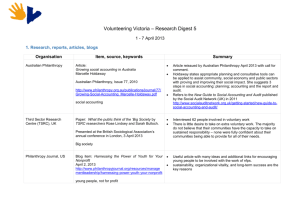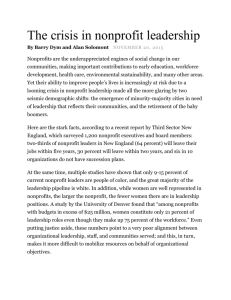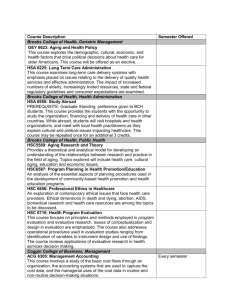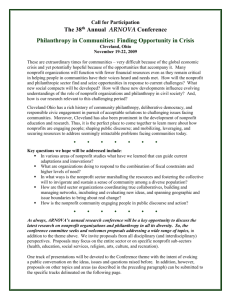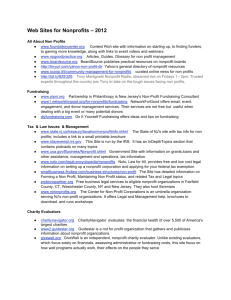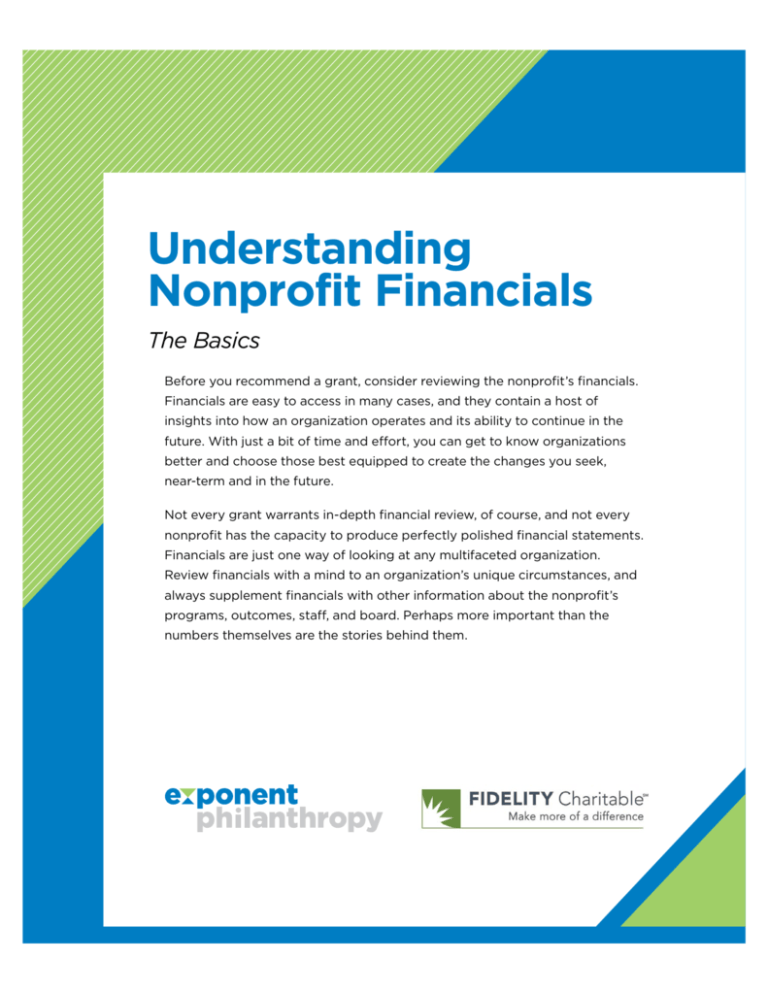
Understanding
Nonprofit Financials
The Basics
Before you recommend a grant, consider reviewing the nonprofit’s financials.
Financials are easy to access in many cases, and they contain a host of
insights into how an organization operates and its ability to continue in the
future. With just a bit of time and effort, you can get to know organizations
better and choose those best equipped to create the changes you seek,
near-term and in the future.
Not every grant warrants in-depth financial review, of course, and not every
nonprofit has the capacity to produce perfectly polished financial statements.
Financials are just one way of looking at any multifaceted organization.
Review financials with a mind to an organization’s unique circumstances, and
always supplement financials with other information about the nonprofit’s
programs, outcomes, staff, and board. Perhaps more important than the
numbers themselves are the stories behind them.
© 2014 Exponent Philanthropy. All rights reserved. www.exponentphilanthropy.org
Terms to Know
đƫ Assets represent what the nonprofit owns. Current assets are the sum of all assets that
could be converted to cash in less than one year, such as cash and cash equivalents or
accounts receivable. Long-term assets are the sum of all other assets, such as property or
long-term CDs.
đƫ Liabilities represent what the nonprofit owes. Current liabilities are the sum of all money
due within one year, including debt; long-term liabilities are the sum of all other liabilities.
đƫ Net assets, or the equivalent of a nonprofit’s net worth, equals total assets minus total
liabilities. Unrestricted net assets are the portion of net assets that are free from donorimposed stipulations and used for general operations. Temporarily restricted net assets are
the portion of net assets subject to donor-imposed stipulations that will be met by actions
of the organization and/or the passage of time. Permanently restricted net assets are the
portion of net assets subject to donorimposed stipulations that the gift be maintained in
perpetuity by the organization.
Where to Find Financial Information
A fairly simple review using any of the sources below will give you information about a
nonprofit’s finances. As you get more comfortable with financials, or seek detailed information
about particular organizations, you can examine financials more extensively.
đƫ Charity rating services—These web-based rating services are great starting points
for information about nonprofits you are considering. They typically analyze financial
statements as part of their rating methodologies.
đƫ Annual reports—Many nonprofits voluntarily publish annual reports, and they tend to
include financial information as well as a report on the year’s activities. The financial
information may be from the organization’s Form 990 (annual information return) or
financial statements.
đƫ IRS Form 990—Perhaps the most accessible source of information on virtually any nonprofit
with annual gross receipts of $25,000 or more, the Form 990 is filed annually and provides
a host of financial information as well as information about a nonprofit’s governance and
oversight.
đƫ Financial statements (audited or unaudited)—Many nonprofits subject their financial
statements (statement of financial position, statement of activities, statement of cash flows)
to an auditor’s outside review and testing, but other nonprofits are likely to have unaudited
financial statements available for review.
đƫ Budgets—By comparing budgets to financial statements, you will see how nonprofits are
progressing and may notice trends from one year to the next.
1
© 2014 Exponent Philanthropy. All rights reserved. www.exponentphilanthropy.org
For larger organizations, most of the above will be available online. For smaller organizations,
your best bet may be to contact them directly for internal documents. Not only will you be
more likely to receive the information you’re requesting, but you’ll also get firsthand experience
in how the organization responds to a donor’s requests and questions.
CHARITY RATING SERVICES
A number of watchdog groups rate nonprofits based on financial information found in annual
returns and audited financial statements, including the following popular organizations:
đƫ American Institute of Philanthropy assigns letter grades for 500 major American charities
from A (Excellent) to F (Poor) based on how the organization uses its funding. It bases
its ratings on a nonprofit’s annual report, complete audited financial statements, and IRS
Form 990 with Schedule A. Generally, top-rated charities openly share audited financial
statements and tax forms, spend less than $25 to raise $100, and allocate at least 75% of
income to charitable programs (not fundraising or administration). www.charitywatch.org
đƫ Charity Navigator rates more than 5,500 of America’s largest charities according to
efficiency and capacity to sustain programs. It assigns zero stars (Exceptionally Poor) to
four stars (Exceptional) based on program expenses, administrative expenses, fundraising
expenses, working capital, and annual growth as reported on IRS Form 990.
www.charitynavigator.org
đƫ Better Business Bureau® Wise Giving Alliance provides information for more than
600 charities, including tax status, missions, programs, services, fundraising methods,
administrative and fundraising expenses, and extent to which the organization meets the
BBB’s 20 Standards for Charity Accountability—standards for how charitable organizations
govern, spend their money, represent themselves to the public, and disclose information.
www.give.org
Although ratings can be a helpful first step in judging a nonprofit’s financial health, don’t stop
there. Dig deeper for a more complete picture.
ANNUAL REPORTS
Nonprofits aren’t required by law to publish annual reports, but many choose to as a way to
celebrate their accomplishments. Nonprofit annual reports range from simple 2-page PDFs to
elaborate bound documents—there is no standard format—but all tend to include narratives and
accompanying financials. Most are easily accessible from a nonprofit’s website.
In contrast to other sources of financial information, organizations use their annual reports
as a way to provide financials in context. As a potential donor, they can orient you to what a
nonprofit does and why.
2
© 2014 Exponent Philanthropy. All rights reserved. www.exponentphilanthropy.org
What are its goals? Why does it choose to spend its resources in particular ways? What are
its results and programmatic outcomes? Annual reports also tend to supplement financial
statements with charts, graphs, or other visuals to convey important points or trends.
IRS FORM 990
Many donors turn to IRS Form 990 for nonprofit financials. The form, a required annual filing
for most public charities, is publicly available for review, free of charge, at www.guidestar.org.
GuideStar® is a comprehensive database of information on more than 1.5 million U.S. charities.
In addition to other services, GuideStar® helps donors research nonprofits by providing
information on mission, programs, results, leadership, and financials.
The 990s posted by GuideStar come from two sources: the IRS and the organizations
themselves. New 990s arrive from the IRS monthly, and organizations can post their 990s at
any time. Although 990s tend to be posted by GuideStar just 2 months after being filed with the
IRS, there is no date on which all 990s are due to the IRS. A nonprofit’s filing date is determined
by the end of its fiscal year, with 990s due by the 15th day of the 5th month after its fiscal year
ends (e.g., May 15 for organizations with a December 31 year end, November 15 for organizations
with a June 30 fiscal year end). Organizations can also receive up to two 90-day extensions.
If you cannot find an organization’s Form 990 at GuideStar, keeping in mind the above dates,
check the organization’s website or ask the organization if it has filed yet.
Redesigned for tax year 2008, the new Form 990 focuses on financials and significant issues
of governance, oversight, and policy. The financial information provided here may differ slightly
from that reported in the organization’s financial statements (see next section); 990s may follow
cash or accrual basis accounting whereas financial statements conform with generally accepted
accounting principles (GAAP).
For a snapshot of a nonprofit’s financial health, pay attention to:
đƫ Part III (Statement of Program Service Accomplishments)—A snapshot of the organization’s
three largest programs (and associated expenses and revenue) during the previous year
đƫ Part VII (Compensation of Officers, Directors, Trustees, Key Employees, Highest
Compensated Employees, and Independent Contractors)—The compensation paid to
officers, staff, and independent contractors
đƫ Part VIII (Statement of Revenue)—How much income did the organization receive? Are the
funding sources diverse and sustainable?
đƫ Part IX (Statement of Functional Expenses)—How does the organization allocate its
resources? How does the amount spent on programs compare to what is spent on
management, administration, or fundraising?
đƫ Part X (Balance Sheet)—The organization’s assets, liabilities, and net assets (or fund
balances) paint a picture of its overall financial strength or weakness. Are the types of
assets and liabilities appropriate to the nonprofit’s work? How much cash and
short-term investments are on hand? How much debt exists?
© 2014 Exponent Philanthropy. All rights reserved. www.exponentphilanthropy.org
3
FINANCIAL STATEMENTS (AUDITED OR UNAUDITED)
Many larger nonprofits subject their financial statements audits by an outside CPA; few small
nonprofits do. Audits may be required by a nonprofit’s board, lender, major funder, or state. If a
nonprofit receives and spends more than $500,000 from the federal government, for example,
an audit is required by federal law.
Audited financials tend to be available 6 to 9 months after an organization’s fiscal year end (with
June 30 and December 31 as the most common fiscal year ends). Although some organizations
may take longer to deliver their audited financials, due to less staff capacity or particularly
complex operations, delays of much longer may indicate inadequate preparation or poor
responsiveness to the auditor’s requests for information.
When reviewing an audit report, look for the following components:
đƫ Opinion letter, either unqualified, given by the auditor without reservations about accuracy
or internal controls; or qualified, with reservations
đƫ Financial statements, including a statement of financial position, statement of activities, and
statement of cash flows (see below for details on each)
đƫ Notes to the financial reports, providing important facts about the nonprofit’s structure,
accounting policies, loans, leases, unusual or significant transactions, litigation, and more
đƫ Management letter, written to those who govern the nonprofit, highlighting any deficiencies
in internal controls, even minor ones
NOTE: A full audit is the highest level of financial review by a CPA and involves testing and balancing to
ensure that information in the financial statements is accurate. In lieu of a full audit, a CPA may prepare
two different financial reports: a review or a compilation. Reviews involve some review by a CPA, usually
enough to provide limited assurance about accuracy, but not as much as a full audit. For a compilation,
a CPA compiles the financial statements based on information provided by the organization but without
any review.
4
© 2014 Exponent Philanthropy. All rights reserved. www.exponentphilanthropy.org
The most common financial statements include:
Statement of financial position—Also known as a balance sheet, this statement shows a
nonprofit’s sources of income, expenditures, assets, and liabilities at a particular point in time.
To see trends over time, it’s very helpful to review balance sheets for several (3 to 5) years
Consider:
đƫ Types of assets and liabilities—Are they appropriate to the nonprofit’s work and comparable
to organizations with similar missions?
đƫ Cash reserves—Is there enough cash and short-term investments on hand to cover at least a
few months of operating expenses?
đƫ Receivables—Is the nonprofit collecting pledges in a timely fashion?
đƫ Total liabilities—How much debt exists, and what is it used for?
đƫ Unrestricted net assets—How sizeable is the nonprofit’s operating cushion?
Statement of activities—Also known as an income statement, this statement shows income
and expenses for a certain period of time. It presents income less related expenses to arrive at
overall profits (or deficits). To see trends over time, it’s very helpful to review income statements
for several (3 to 5) years. Consider:
đƫ Types of revenue and expenses—Do the types fit with how the organization works and how
other similar organizations operate? Do any significant changes from the previous year fit
with changes in operations?
đƫ Revenue streams and trends—Does the organization rely on one or few sources of income?
Is there a decline or increase in revenue over time? How will your grant impact the
nonprofit’s revenue profile?
đƫ Expense trends—How much is spent on administrative fees, salaries, and fundraising relative
to what is spent on programs? Are there large amounts of miscellaneous expenses?
đƫ Relative growth of expenses and revenues—Are increases in revenue keeping up with
increases in expenses?
đƫ Bottom line over time—Total revenue minus total expenses equals gains (or losses). Are there
operating deficits for two or more consecutive years? If so, why? Footnotes or management
comments in annual reports can illuminate this.
5
© 2014 Exponent Philanthropy. All rights reserved. www.exponentphilanthropy.org
Statement of cash flows— Showing the flow of cash in and out of an organization, this internal
report reflects the short-term viability of a nonprofit, or its ability to pay bills. Cash flow
statements are generally divided into three sections—operating activities, investing activities,
and financing activities—showing the amount of cash generated and used in daily operations
compared to that provided by sources outside the organization, such as investments or loans.
BUDGETS
As the internal documents that organizations use for planning purposes, budgets ideally exist
for the organization as a whole as well as for any projects for which the nonprofit is seeking
support. When you review operational or project budgets, ask the following questions:
đƫ Is the budget realistic in time line and ability to fully fund the project or operations?
đƫ Is this budget within the means of the organization? What are the funding sources? Are
they new or old? Does the organization have the necessary staff, experience, and financial
sophistication to execute the plan?
đƫ Is the budget well planned and clearly communicated? Is it based on good assumptions?
Does it consider risks to revenues, expenses, and timing? Does it generate confidence in the
nonprofit’s capabilities?
đƫ For project budgets: How will a project impact the overall operating budget? Do you
perceive a favorable cost-benefit ratio? If the project continues beyond the grant period, is
there verifiable support for future funding, or is the program self-sustaining?
Supplementing Financials to Create a Complete Picture
Reviewing a nonprofit’s financials is a great way to get to know it better—and a great way to
further inform your giving. But financials are just one part of what makes an effective nonprofit.
In fact, nonprofits need many characteristics to be effective, including:
đƫ Clear mission and purpose
đƫ Ability to perform key functions
đƫ Effective practices, procedures, and policies
đƫ Good people
đƫ Ability to sustain itself for the future
As you consider which nonprofits to support, be sure to review financials in context.
6
© 2014 Exponent Philanthropy. All rights reserved. www.exponentphilanthropy.org
Additional Resources
Exponent Philanthropy Find seminars and publications to help you navigate nonprofit
financials. www.exponentphilanthropy.org
Project Streamline A collaborative effort of funders and nonprofits working to lessen the
burdens of grant application and reporting, including preparing and reviewing financials.
www.projectstreamline.org
Understanding Nonprofit Financial Statements, Third Edition A publication and CD-ROM of
nononsense explanations to help you quickly understand financial concepts.
www.boardsource.org
About Exponent Philanthropy
Exponent Philanthropy %/ƫƫ2%.*0ƫ)!)!./$%,ƫ+.#*%60%+*ƫ0$0ƫ,.+2% !/ƫ.!/+1.!/ƫ* ƫ
2(1(!ƫ+**!0%+*/ƫ0+ƫ$!(,ƫ0$+1/* /ƫ+"ƫ,$%(*0$.+,%/0/ƫ3%0$ƫ"!3ƫ+.ƫ*+ƫ/0""ƫ)'!ƫ0$!ƫ)+/0ƫ
+"ƫ0$!ƫ)%*10!/ƫ0$!5ƫ$2!ƫ* ƫ0$!ƫ +((./ƫ0$!5ƫ#%2!ċ
DISCLAIMER: Exponent Philanthropy cannot be held liable for the information provided in this
tear sheet. We strongly encourage you to consult your attorney to ensure compliance with
federal and state laws.
This reprint of the 2010 issue is supplied by the Fidelity® Charitable Gift Fund (“Gift Fund”) with permission fromƫ
Exponent Philanthropy. The Gift Fund is an independent public charity with a donor-advised fund program. Various
Fidelity companies provide investment management and administrative services to the Gift Fund. Fidelity and Fidelity
Investments are registered service marks of FMR LLC, used by the Gift Fund under license. Clearing, custody, or
other brokerage services maybe be provided by National Financial Services LLC or Fidelity Brokerage Services LLC,
Members NYSE, SIPC.
7
© 2014 Exponent Philanthropy. All rights reserved. www.exponentphilanthropy.org



